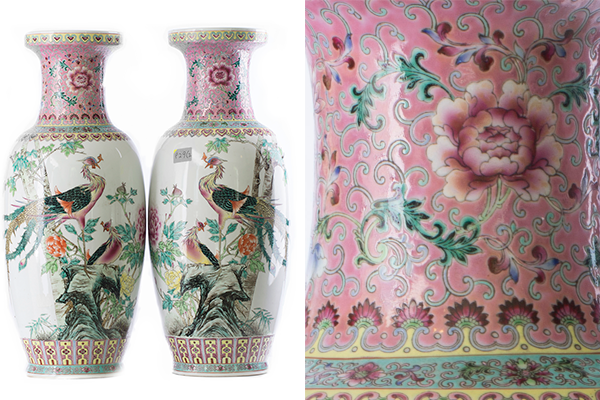Specs
History
This set of two porcelain vases depicts phoenixes perched on tree peonies (Chinese: 牡丹, pronounced ‘mu dan’) in bloom. These wucai (五彩, which gives a literal translation of ‘five colours’) porcelain vases features an exquisite design with a mixture of green and pink colour palettes, and is thus said to be of the famille verte and famille rose class of porcelain wares. The famille verte class of porcelain features designs with green and iron red enamel, and peaked in popularity in the period of Emperor Kangxi’s reign (1661-1720), while the famille rose class of porcelain was only introduced circa 1720 and primarily featured pink and purple colours. Its introduction allowed artists to paint designs with a greater range of colour on porcelain, and the famille rose enamel remained popular throughout the 18th and 19th Centuries. Wucai porcelain typically refers to Chinese porcelain decorated in this style dating from the Ming period (1368-1642), in particular, during the rule of Emperor Jiajing (1522-1566), Emperor Longqing (1567-1572) and Emperor Wanli (1573-1619).
During their reign, they commissioned a variety of porcelain items to be fashioned under the influence of this decorative style. However, the combination of the famille rose style of enamel hints of the 18th Century influence that this pair of vases embody. The painting on each porcelain vase is of a phoenix perched on a tree peony in bloom, a propitious illustration to many within the Chinese culture. Mythological origins of the phoenix depicts it as a type of celestial power sent from the heavens to the Empress. Thus, when a house is decorated with depictions of the phoenix, it symbolised that the people who dwelled in that house were loyal and honest. An alternative interpretation would be as such: a phoenix only stays where the ruler is without darkness and corruption (Chinese: 政治清明, pronounced ‘zhèng zhì qīng míng’). Images of this ancient bird have appeared in China since the Hongshan neolithic period as motifs on jade and pottery as well as on decorative bronze figurines. The coupling of two phoenixes together as in the case when these two vases, being mirror images of each other, are placed together, is particularly auspicious. When two phoenixes are coupled together, known collectively as the fenghuang, where one is generally thought of to be a male (referred to in Chinese as ‘feng’, 鳳) while the other a female (referred to in Chinese as ‘huang’, 凰), they are believed to be strong symbols of good luck.
When the male and female phoenixes are positioned to face each other, the fenghuang represents the direction of the South. They are also fortuitous symbols of high virtue, grace, peace, and prosperity, and represents the union of yin and yang. Each part of the fenghuang’s body is thought to portray a word. The head represents virtue (Chinese: 德, pronounced ‘dé’); the wing, duty (Chinese: 義, pronounced ‘yì’); the back, propriety (Chinese: 禮, pronounced ‘lì’); the abdomen, credibility (Chinese: 信, pronounced ‘xin’); and the chest, mercy (Chinese: 仁, pronounced ‘ren’). The peonies that are depicted around the phoenixes reinforces to the emblematic meaning of the vase, since they are both iconic motifs in the Chinese culture. As a flower associated with the springtime, taken together with the favourable phoenix, they may be interpreted collectively as auspicious symbols for marriage and fertility. On its own, the tree peony (Chinese: 牡丹, pronounced ‘mu dan’) signifies the third month of the lunar calendar and is associated with longevity, loyalty, happiness and eternal beauty. Occasionally, the peony may grow as a double, which gives it the appearance of strings of monetary coins, leading men to also associate the peony as a flower of prosperity and wealth. For this reason, the peony has gained an alternative name, fuguihua (富贵花), which translates to “flower of wealth and honour”. A tree peony portrayed in a vase (Chinese: 瓶, pronounced ‘píng’), however, represents wealth and honour, attributed to the peony, and has the additional hidden meaning of peace, because the vase is a rebus for the word peace in the Chinese language (Chinese: 平 安, pronounced ‘píng ān’).
Pricing
Please inquire and get in touch via our CONTACT US page





RECENT COMMENTS